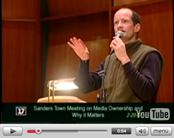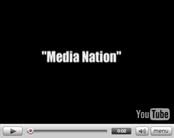Discuss E-List
Essential Resources Guide
FREE Teaching Resources
Membership Benefits
Partner Discounts
Summit 2006
Teaching the Language of the Image: 24 Persuasive Techniques
Developing A Media Education Language:
From Persuasive Techniques to Analytical Tools (PDF version)
1. Symbols: Persuading through the use of idea-conveyances (an American flag on a lapel pin) that associate one thing (a politician) with another (support for his speeches or policies). Symbols are often phrases (“Just Do It”), images (the famous “Earth seen from space” photo) graphic brands(McDonald’s Golden Arches), or icons (well-known politicians, athletes, or artists). Symbols are rarely used by accident or chance; they are usually employed very carefully.
2. Big Lie: Persuading through dishonesty; not telling the truth about X. An easy technique to spot in advertising (“Smoking makes you glamorous,” “Drinking makes you cool”), but sometimes harder to spot in political propaganda. This is where reading a variety of independent media sources comes in handy. cal reflection—not an invitation for hypnosis.
3. Flattery: Persuading by complimenting insincerely or excessively. Advertisers use this technique all the time (“You deserve a break today”), and television pro- grams (including so-called “reality TV”) uses this technique in a more subtle way, suggesting that the audience is more smart, cool, etc. than people on the screen.
4. Hyperbole: Persuading by making exaggerated claims. Found all the time in advertising media (“The best smoke ever!”), and often in political propaganda.
5. Bribery: Persuading through the offering of a bribe—money, favors, savings,or a little something extra. Advertisements use this technique all the time (“Act now and we’ll throw in extra X or save you Y dollars.”)
6. Bandwagon: Persuading by insisting that “everyone’s doing X.” Works in both advertising and political propaganda.
7. Scapegoating: Persuading by blaming problems on one individual or group (The Nazis blaming Jews, for example, for Germany’s problems during the 1930s).
8. Simple Solutions: Persuading by offering a simple solution to either a manufactured or more complex problem. (“Take these pills and lose all the weight you need!” What about a responsible diet, regular exercise, the influence of genetics on one’s weight, and a healthy sense of individual self-esteem despite being larger than some?)
9. Rhetorical Questions: Persuading through the asking of questions designed to provoke further exploration or generate a certain predicted response. (“Do you want greasy hair?” “Why did politician X lie about Y”?)
10. Straw Man: Persuading by setting up your opponent’s argument and then knocking it down with your own argument. (“While my opponent John Kerry argues that the Iraq War is misguided, it is clear that the U.S. invasion of Iraq was necessary to destroy weapons of mass destruction, overthrow the corrupt Hussein regime, and liberate Iraq from emerging terrorist groups.”)
Download the PDF to read more



![View your cart items []](/sites/default/modules/ecommerce/cart/images/cart_empty.png)






